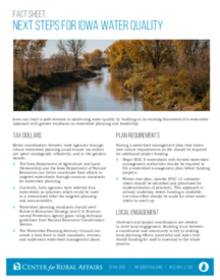Tax dollars
Better coordination between state agencies through robust watershed planning could ensure tax dollars are spent strategically, efficiently, and to the greatest benefit.
- The Iowa Department of Agriculture and Land Stewardship and the Iowa Department of Natural Resources can better coordinate their efforts in targeted watersheds through common standards for watershed planning.
- Currently, both agencies have selected four watersheds as priorities which could be used in a streamlined effort for targeted planning and accountability.
- Watershed planning standards should meet Nutrient Reduction Strategy and U.S. Environmental Protection Agency goals using technical guidelines from Natural Resources Conservation Service.
- The Watershed Planning Advisory Council can create a task force to draft standards, oversee, and implement watershed management plans.
Plan requirements
Having a watershed management plan that meets new robust requirements on file should be required for additional project funding.
- Major HUC-8 watersheds with formed watershed management authorities should be required to file a watershed management plan before funding projects.
- Within that plan, specific HUC-12 subwatersheds should be identified and prioritized for implementation of practices. This approach is already underway where funding is available, but extra effort should be made for other watersheds to catch up.
Local engagement
Outreach and project coordinators are needed to drive local engagement. Building trust between a coordinator and community is key in making local planning efforts successful and takes time. Stable funding for staff is essential to the whole process.
Soil importance
A farm certification program focused on soil health and rebuilding topsoil would provide incentives for farms outside of a watershed organization or a prioritized subwatershed to meet the goals of the Nutrient Reduction Strategy.
- Tools used for watershed planning can be used for farm-level planning, too. Metrics can include soil carbon, biological activity, organic matter, and soil depth.
- More investment in research to clarify common metrics and a range of benefits for soil health would help.
- In our report, “Catching Waves: Farmers Gauge Risk to Advance Water Quality in Iowa,” regulatory certainty was cited as a top concern. An existing farm certification program in Minnesota guarantees farmers regulatory certainty for 10 years in return for more on-farm conservation with farm-level planning and can offer lessons.
Long term
Iowa leads in some aspects of its approach to the state nutrient reduction strategy, but lags in having a long-term plan for water quality monitoring.
- One shift that has occurred is moving the bulk of water quality monitoring activities from the Iowa Department of Natural Resources to the IIHR-Hydroscience & Engineering department at the University of Iowa.
- A long-term framework should be the work of experts at regent universities with support from state agencies.
- Water quality monitoring would also benefit from a focus on metrics outside of nitrogen and phosphorus by including health of aquatic life or other pollutants such as microcystins, chlorophyll-a, endocrine disruptors, pharmaceuticals, and indicators of harmful algae blooms.
More incentives and policies
Other policies and incentives can be incorporated over time to advance water quality.
- Iowa could match available federal funds for Conservation Reserve Enhancement Program wetlands dollar for dollar, similar to an effort underway in Minnesota.
- Funding the Natural Resource and Outdoor Recreation Trust Fund would generate nearly $180 million annually. With this dedicated funding source, the personnel capacities of Soil and Water Conservation Districts could be expanded with $12 to $15 million.
- Other possible incentives:
- Encourage grazing of cover crops—few incentives are available within the federal farm bill for working conservation lands to encourage grazing.
- Recognition and rewards could also be offered for watersheds once 80 percent of its agricultural land area incorporates no-till, cover crops, or achieves other benchmarks.


